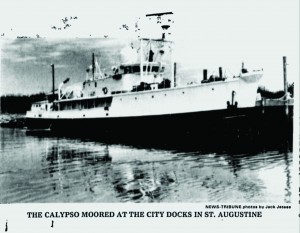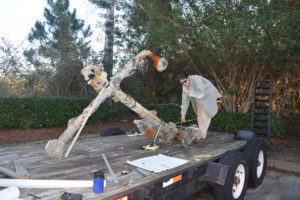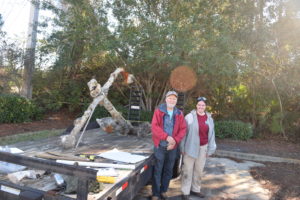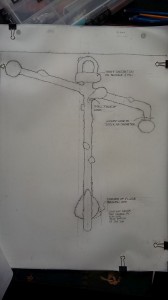On January 27, archaeologists with the Museum’s research arm, the Lighthouse Archaeological Maritime Program (LAMP), received an interesting call about a historic anchor that had recently been recovered from Ponce Inlet, about an hour south of St. Augustine.

The Calypso docked at St. Augustine in 1985, after the completion of an extensive overhaul by St. Augustine Trawlers. (photo from the Daytona Beach Morning Journal, April 13, 1985)
When LAMP received the call from a charter boat captain who runs his boat out of Ponce Inlet.
The story told was not one of the origin of the anchor, but rather of an interesting turn of events after the anchor was parted from its original vessel.
As the story goes, the anchor was plucked from the sea floor by none other than Jacques Cousteau, the well-known scientist, conservationist, and explorer, while he and his crew were bringing his research vessel Calypso to St. Augustine for an extensive overhaul in 1984.
Cousteau and his crew were approximately 40 miles from St. Augustine when they discovered the anchor grown into the live bottom of a fishing spot. It was in about 128 feet of water, and while they looked for a nearby wreck or associated artifacts, they found none. They retrieved the anchor and brought it with them to St. Augustine, where Cousteau sold it to the Timmons family, the owners of St. Augustine Trawlers, who were completing the overhaul on Calypso.
The Timmons family took the anchor to Ponce Inlet, where it sat in front of their restaurant, Down the Hatch. When the restaurant changed hands in later years, the anchor stayed with the restaurant. The new owner received a permit to use the anchor as a mooring, and returned it to the water. Unfortunately, a storm separated the anchor from the vessel it was holding, and the anchor was lost a second time.
Earlier this year, the charter boat captain that initially contacted LAMP snagged the anchor with his own vessel. According to the mooring permit obtained by the second restaurant owner, this anchor was recovered from the same area that the Cousteau anchor was placed in to serve as a mooring, making it very likely they are one in the same.

Here Kira Sund uses a plumb bob to take measurements on specific points during the recording of the anchor.
On January 29, two lighthouse volunteers, Kira Sund and Mike Barton, took a trip to Port Orange to record and photograph the anchor.
Depending on how an anchor is found, and how it parted from its original ship, it can be difficult to tell any specific information about an individual anchor.
Sometimes they are found on known wreck sites, or can be tied to nearby wreckage, but often they are found alone, having been cut from the ship in some sort of emergency or unintentionally separated by a parting line or some other circumstance.
Regardless, they are often “the last remaining visible symbol of an incident at sea,” as stated by the Big Anchor Project, and it is therefore worthy of our time to record both their form and what we can learn of their story with as much detail as possible.
Its form most closely matches that of the 1841 Admiralty pattern anchor, telling us it was made sometime after 1841. Other than this rough date, and its interesting connection to Cousteau, little is known about this anchor.
What we do know, along with the the drawing done by our volunteers, will be reported to the Big Anchor Project to join their database of historic anchors found world wide.
Archaeologist Olivia McDaniel first joined the St. Augustine Lighthouse & Museum team in 2012 as a student at LAMP’s Underwater Archaeology Field School. She officially joined the lighthouse family as an archaeologist in July, 2014, after completing her bachelor’s degree at the University of Idaho.



